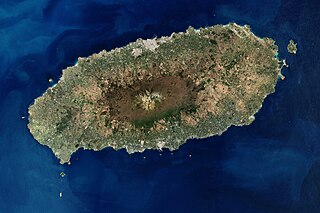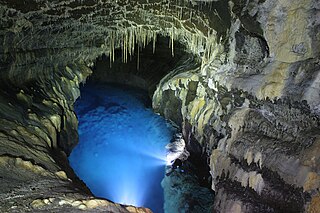
Jeju Province, officially Jeju Special Self-Governing Province, is the southernmost province of South Korea, consisting of eight inhabited and 55 uninhabited islands, including Mara Island, Udo Island, the Chuja Archipelago, and the country's largest island, Jeju Island. The province is located in the Korea Strait, with the Korean Peninsula to the northwest, Japan to the east, and China to the west. The province has two cities: the capital Jeju City, on the northern half of the island and Seogwipo, on the southern half of the island. The island is home to the shield volcano Hallasan, the highest point in South Korea. Jeju and Korean are the official languages of the province, and the vast majority of residents are bilingual.

Hallasan (Korean: 한라산) is a shield volcano on Jeju Island in South Korea. Its summit, at 1,947 m (6,388 ft), is the highest point in the country. The area around the mountain is a designated national park, named Hallasan National Park. Hallasan is commonly considered to be one of the three main mountains of South Korea, along with Jirisan and Seoraksan.

Jeju City is the capital of the Jeju Province in South Korea and the largest city on Jeju Island. The city is served by Jeju International Airport.

Seogwipo is the second-largest city on Jeju Island, settled on a rocky volcanic coastline in the southern part of Jeju Province, South Korea. In July 2006, Seogwipo's boundaries were expanded to include the entire southern half of Jeju island. A UNESCO World Heritage Site and 2002 FIFA World Cup host, it had a population of 192,566 as of the end of February, 2024.

A parasitic cone is the cone-shaped accumulation of volcanic material not part of the central vent of a volcano. It forms from eruptions from fractures on the flank of the volcano. These fractures occur because the flank of the volcano is unstable. Eventually, the fractures reach the magma chamber and generate eruptions called flank eruptions, which, in turn, produce a parasitic cone.

Jeju Island is South Korea's largest island, covering an area of 1,833.2 km2 (707.8 sq mi), which is 1.83% of the total area of the country. Alongside outlying islands, it is part of Jeju Province and makes up the majority of the province.

The Jeju Volcanic Island and Lava Tubes is a World Heritage Site in South Korea. It was inscribed as one of the UNESCO World Heritage Sites in 2007 because of the Geomunoreum Lava Tube System and the exhibition of diverse and accessible volcanic features which are considered to demonstrate a distinctive and valuable contribution to the understanding of global volcanism.

Gotjawal (Korean: 곶자왈) is a Jeju-language term for a dense and wild forest. The term is now used to describe the forest biome of Jeju Island, in Jeju Province, South Korea.

Jeju Olle Trail (Korean: 제주올레길) is a long-distance footpath on Jeju Island, in Jeju Province, South Korea. The trail consists of 21 connected numbered main routes, 6 sub-routes, and a short spur that connects to Jeju International Airport. On average, the routes are 16 km in length and total 437 km. They mainly follow Jeju's coastline and around its outlying islands, passing beaches, fishing villages, indigenous forest, tourist destinations, and urban centers. The exact length and locations change over time as trails are modified or re-routed. Jeju Olle Trail was envisioned and developed by former journalist Suh Myung-sook.

Udo, also known as U Island and sometimes Soseom (소섬), is an island in Jeju Province, South Korea. It is 2.8 km (1.7 mi) off the coast of Jeju Island, and is the second-largest island in the province.

Seongsan Ilchulbong (Korean: 성산일출봉), also called Sunrise Peak, is a volcano on eastern Jeju Island, in Seongsan-ri, Seogwipo, Jeju Province, South Korea. It is 182 meters high and has a volcanic crater at the top.
Seolmundae Halmang (Korean: 설문대할망) is a creator goddess in the mythology of Jeju Island. She features prominently in Jeju shamanism. There are a diverse array of stories surrounding her, with many describing her creating the various geological features of Jeju Island. Her stories are said to have elements of both mythology and tall tales; legends attribute both divine and human properties to her, including mortality.
Gujwa is a town located in Jeju City, Jeju Province, South Korea.

Hallim is a town located in Jeju City, Jeju Province, South Korea. The population of Hallim is 20,910 people and 10,737 households.

Sanbangsan is a volcano located on the southwest coast of Jeju Island, in Andeok-myeon, Seogwipo, Jeju Province, South Korea. It is a trachytic lava dome that is 395 m (1,296 ft) tall.

Geomunoreum, alternatively Geomeunoreum (검은오름), is an oreum around Jocheon and Gujwa in Jeju City, Jeju Province, South Korea.
Yongnuni Oreum is an oreum in Gujwa, Jeju City, Jeju Province, South Korea.
Gama Oreum is an oreum in Cheongsu-ri, Hangyeong-myeon, Jeju City, Jeju Province, South Korea.

Geomeun Oreum, popularly called Geum Oreum and alternately called Geumak, is an oreum in Hallim, Jeju City, Jeju Province, South Korea.

Saebyeol Oreum is an oreum in Aewol, Jeju City, Jeju Province, South Korea. It has an area of 0.522 km2 (0.202 sq mi), circumference of 2,713 m (8,901 ft), and height of 519.3 m (1,704 ft).



















